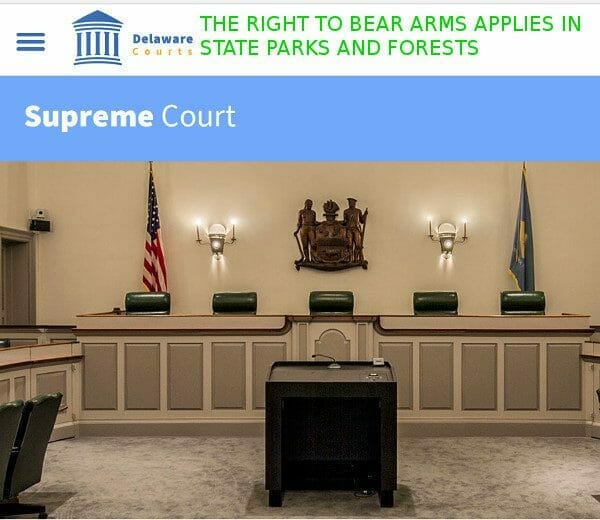
Arizona -(Ammoland.com)- The Supreme Court of the State of Delaware has upheld the right to keep and bear arms provision of the State Constitution, which was enacted in 1987, passing through two separately elected legislatures.
The case was a challenge to the state ban on the possession of weapons in state parks and forest.
In Bridgevile Rifle & Pistol Club v. Small, the court ruled that a ban on the possession and carry of guns, enacted by unelected bureaucrats, was unconstitutional under the Delaware Constitutions Article I, Section 20.
This appeal concerns guns and, as such, has attracted numerous amici curiae raising politically fraught questions concerning gun rights.1 However, at its core, this case raises straightforward questions of Delaware constitutional and administrative law. We are asked whether unelected officials from the State’s parks and forest departments, whose power is expressly limited, can ban (except for a narrow exception for hunting) the possession of guns in state parks and forests in contravention of Delawareans’ rights under the State’s constitution. Clearly they cannot. They lack such authority because they may not pass unconstitutional laws, and the regulations completely eviscerate a core right to keep and bear arms for defense of self and family outside the home–a right this Court has already recognized. As such, the regulations are unconstitutional on their face. Thus, we REVERSE for these reasons and those that follow.
Here is Article I, Section 20 of the Delaware Constitution. The meaning is clear:
“A person has the right to keep and bear arms for the defense of self, family, home and State, and for hunting and recreational use.”
It is interesting to see the logical pretzels the dissent turns in attempting to keep the ban in place. They amount to a number of assertions of Progressive dogma.
Essentially they are:
- There are no pre-existing natural rights to arms.
- The State never explicitly granted a right to arms in its Constitution, early on, so any legislative acts done before the right was added are grandfathered in.
- The legislature never really intended Section 20 to mean what it says.
- England restricted the right to arms in some times and places, so we can do so as well.
- The Second Amendment never applied to the States until recently, so any reasoning based on Heller and McDonald does not apply.
- Nobody challenged the law before, so it must be Constitutional
The dissent drones on for dozens of pages. But it all comes down to the same old Progressive doctrines: the state can do what it wants, and guns are bad.
It is sad that two of five Delaware Supreme Court Justices are willing to ignore the clear words of Delaware’s constitution to obtain a result they want. But it is basic Progressive practice and dogma.
It is heartening that three of the five Justices upheld the clear meaning of Article I, Section 20.
Only six states do not have some provision in their state constitutions that protect the right to keep and bear arms. Those states are California, Iowa, Maryland, Minnesota, New Jersey, and New York.
It is unsurprising that those states include the four of the states that most egregiously infringe on the exercise of Second Amendment rights.
State constitutions provide another layer of protection for the right to keep and bear arms. States, in a federal system, serve as part of the checks and balances that limit government power in the United States.
2017 by Dean Weingarten: Permission to share is granted when this notice is included.
About Dean Weingarten:
Dean Weingarten has been a peace officer, a military officer, was on the University of Wisconsin Pistol Team for four years, and was first certified to teach firearms safety in 1973. He taught the Arizona concealed carry course for fifteen years until the goal of constitutional carry was attained. He has degrees in meteorology and mining engineering, and recently retired from the Department of Defense after a 30-year career in Army Research, Development, Testing, and Evaluation.

